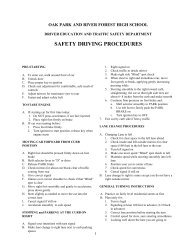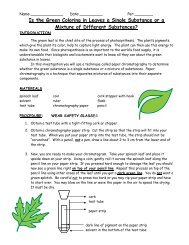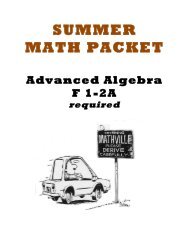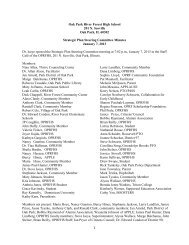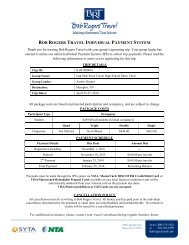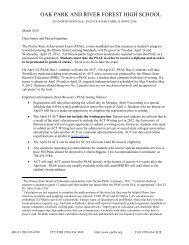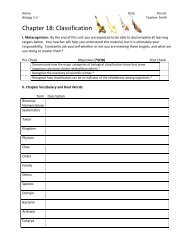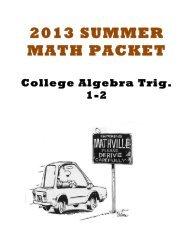PRECALCULUS 1A
PRECALCULUS 1A
PRECALCULUS 1A
Create successful ePaper yourself
Turn your PDF publications into a flip-book with our unique Google optimized e-Paper software.
Dear Parents/Guardians:<br />
CALCULUS CONCEPTS<br />
COURSE SYLLABUS<br />
It is my pleasure to have your child in my class. I believe if we work together we can all be successful<br />
this year. Therefore I have attached a list of classroom expectations and an overview of my grading<br />
policy so we can work together to make this year enlightening and full of discovery. I have also shared<br />
my expectations and grading policy with your child today in class.<br />
I am sure we all recognize the importance of focusing on schoolwork in order to complete any course<br />
with success. I hope you can take a moment to read these expectations and share any feelings or<br />
questions with your child and/or me. Please feel free to contact me with any questions about your<br />
child's progress or any questions in general. Please reach me through email, cavalos@oprfhs.org, or<br />
phone number 434-3351 before 8:00 a.m. or after 3:04 p.m.<br />
In order for me to contact you, please provide me with the following information. Also, please indicate<br />
what method you prefer for me to use in order to contact you. Print your information clearly and sign in<br />
the appropriate place, indicating that you have read this material. Have your child return this page to<br />
me as soon as possible.<br />
Thank you,<br />
Ms. Carmen Avalos<br />
(Please return only the bottom information and keep the top information for your records.)<br />
(Please print)<br />
Student<br />
name:<br />
Parents/Guardians:<br />
Father:<br />
Mother:<br />
(home phone) (work/cell phone) (email)<br />
Preferred method of contact:<br />
Student signature:<br />
(home phone) (work/cell phone) (email)<br />
Preferred method of contact:<br />
Parent signature:<br />
Comments:<br />
______________________________________________________________________________________<br />
______________________________________________________________________________________
WELCOME TO CALCULUS CONCEPTS<br />
COURSE SYLLABUS<br />
MS. AVALOS<br />
COURSE OUTLINE: Designed for students who wish to continue on a calculus pathway. First<br />
semester focuses on topics leading to the larger calculus concepts with an<br />
emphasis on the library of functions from a calculus point of view. Second<br />
semester focuses on the derivative, one of the key concepts in calculus. A<br />
graphing calculator is required.<br />
COURSE TEXTS:<br />
CALCULUS SINGLE VARIABLE 4 th EDITION and Study Guides<br />
This class represents a cooperative effort: each of us has a job to do to insure that learning takes<br />
place. As the teacher, it is my job to plan lessons, write exams and quizzes, provide extra help the<br />
students need, and grade tests promptly. As the student, it is your responsibility to come to class<br />
each day ready to learn. That means you should be prepared with necessary materials and<br />
homework.<br />
Supplies:<br />
Homework:<br />
Large spiral notebook that will be used ONLY for math, at least 2 pencils and eraser<br />
(tests must be taken in pencil or will deduct 5 points from the test score),<br />
pocket folder for handouts, homework and tests, and a graphing calculator!<br />
Homework is assigned daily. Please follow the assignment sheet that is given with every unit study<br />
guide. Write down and attempt every problem before you come to class and correct all mistakes<br />
immediately when we go over it in class. All homework from the text book should be done in your<br />
notebook. Label each homework with the corresponding assignment number and make sure it is large<br />
enough to stand out from the rest of the work. Each homework assignment is worth 2 points, 1 point<br />
if turned in late. Homework is not graded for accuracy. If 95% of it is done or attempted then you<br />
will receive full credit otherwise you can turn it in the NEXT day only for half credit.<br />
Skyward and Homework: On skyward there will be a range of dates where homework was due<br />
and total possible points that could have been achieved. Your total points will reflect on where you<br />
turn in your homework , turned it in late or did not turn it in. If you received 7/10 that means you did<br />
not turn in all your homework in on time for some days. For specifics assignment numbers and dates<br />
please contact me.<br />
Late assignments will not be accepted for full credit and will not be accepted at all after 2 days,<br />
unless you were sick (in that case you have 1 day for each day absent to do make up work).<br />
Homework is mainly good for studying for tests. Some homework problems often reappear on tests<br />
after the material has been covered and tested. It is therefore highly recommended to keep all study<br />
guides and homework to review previous material that could appear on the current test. Homework<br />
counts for approximately 30% of 9 week grade.<br />
Parents:<br />
Notes:<br />
Grading:<br />
Please know that homework is given every day. Ask your son/daughter to see their completed<br />
assignment occasionally, if not daily. They will be giving an assignment sheet at the beginning of each<br />
chapter. Please contact me through email or phone for information about your child’s<br />
progress when needed.<br />
Notes should always be taken in your math notebook. They should be dated and contain everything I<br />
write on the board or through the overhead projector. Notes should also include any sample problems<br />
done in class.<br />
Grades are based mostly on tests ( 70%) and homework (including projects) ( 30%). Cutoffs for<br />
each grade are percents - A(90%) B(80%) C(70%) D(60%) F(below 60%). You can compute your<br />
grade by dividing your points by the possible points.
Absences:<br />
Extra Help:<br />
CAT or CATA<br />
Students:<br />
Helpful<br />
Hints:<br />
ETC:<br />
Common<br />
Sense:<br />
If you have any absences that you know about in advance (for example, field trips, funerals, court<br />
dates. etc.), you must tell me beforehand. In any case, it is your responsibility to find out what<br />
you missed, and make arrangements for making up missed tests and quizzes. You have one day for<br />
each day absent to make up all missed tests and quizzes. (Example: if you are absent 3<br />
days, you have 3 school days to make up all work. Tests and quizzes not taken in those 3<br />
days count as zero.) Also, if you miss a quiz or test due to an unexcused absence, then the quiz or<br />
test automatically becomes a zero. You will not be eligible for any extra tutoring, turning in homework,<br />
making up any test or quiz if your absence is unexcused. The school’s tardy and attendance policy will<br />
be followed at all times.<br />
I will be available for tutoring by appointment after school on a daily basis. Tutoring is also<br />
available all periods in room 393.<br />
Be prepare to work extremely hard. This course has three levels of students, Pre-Calculus, College<br />
Algebra Trig Advanced and College Algebra Trig. Concepts might come easier for those students that<br />
have taken the advanced courses. Even though math came easy to you before, it will be more difficult<br />
in this course because of the rate that material is covered and the depth of the understanding that is<br />
expected of material cover in the previous year.<br />
Review your notes before starting your homework. Your homework is your practice time. Use a pencil.<br />
Complete all the problems. Stay on schedule. Ask questions in class especially concerning your<br />
homework. Find a study buddy. It helps to talk about the homework problems. Be respectful,<br />
courteous, and considerate of your classmates. Only one person can speak and be heard at a time.<br />
Raise your hand if you want to participate. Be prepared to practice a lot. While you will continue to<br />
work on basic mathematics in algebra, you will also be required to analyze more application-based<br />
problems than you have in any previous math course. Enjoy yourself…math is FUN!<br />
Expect a cumulative exam approximately every two weeks.<br />
Do not ask to be excused from an exam the day of the exam.<br />
Cutting class on the day of the exam will result in a grade of zero on that exam.<br />
Cheating on test or quizzes will result in a grade of zero for that assessment.<br />
Don’t be late.<br />
Visit the nurse before or after class.<br />
Food and water is not allowed in class.<br />
Incomplete homework will never be given credit. Skipping graphs would be an example of incomplete<br />
work.<br />
Sloppy work is equivalent to incomplete work. If I can’t read your writing, then print or type.<br />
I seldom give out bathroom passes.<br />
Homework is due at the beginning of class on the due date.<br />
Do not tell me that you did not do your homework because you did not have a calculator.<br />
Keep track of your own grades.<br />
If you take a vacation, you must keep up to date.<br />
Crying is not an effective strategy for successful negotiation.<br />
Smiling is an effective strategy!<br />
It seems that “common sense” is far from common, so I will spell out a few rules. Certain objects have no<br />
business being brought into this (or any) classroom. Examples include, but are not limited to, liquids of any type,<br />
cosmetics, toys of any type, food, candy, etc., and items that violate school rules such as IPODs, cell phones,<br />
jackets, etc. In general, anything that is not needed for class probably does not belong.<br />
As I need to walk around the room, to check homework and offer help, you are to put book bags UNDER your<br />
desks and NOT next to it. Under NO circumstances should your book bag be taking up space ON your desk –<br />
you need that space to take notes on homework or for in-class work. Throwing anything, anytime, anywhere<br />
during class is always a “no no”. Do not leave your desk, except to sharpen your pencil (and then choose your<br />
time carefully). There is a time for talking and a time for listening; if you’re not sure which is which, try listening.
Academic<br />
Integrity:<br />
Classroom<br />
Rules:<br />
Working together on HW and projects where appropriate is strongly encouraged. However, copying<br />
other people’s work is prohibited. If you copy from another student or any other source (or allow a<br />
student to copy your work), you will receive a zero for the assignment and will not be permitted to<br />
redo the assignment. If you are quoting or paraphrasing from an outside source for a project or<br />
paper, be sure to cite the source appropriately.<br />
Cell phone use during any assessment results in an automatic zero on that assessment. You will be<br />
asked to take out, turn off, and place your cell phone on your desk during any assessment. You<br />
cannot use your cell phone as a calculator during class as your TI-84 serves this purpose.<br />
TOPICS COVERED IN CALCULUS CONCEPTS 1-2A<br />
SEMESTER ONE<br />
I. Functions in Calculus<br />
A. Functions, Calculus Style<br />
B. Transformation of Graphs<br />
C. Calculator Graphs<br />
D. What is a function?<br />
E. Composite and Inverse Functions<br />
F. Attributes of Even and Odd Functions<br />
G. Modeling with elementary functions<br />
II.<br />
More on functions<br />
A. Functions and change<br />
B. Exponential functions<br />
C. Piecewise Functions<br />
D. Logarithmic functions<br />
E. Trigonometric functions<br />
F. Powers<br />
G. Polynomials and End Behavior<br />
H. Rational Functions and Asymptotes<br />
III. Limits<br />
A. Introduction to continuity<br />
B. Graphical limits<br />
C. Numerical limits<br />
D. Analytical limits<br />
IV. The Slope Function<br />
A. How do we measure speed?<br />
B. Instantaneous Velocity<br />
C. How do we calculate distance?<br />
D. Riemann Sums<br />
E. Local Linearity<br />
SEMESTER TWO<br />
V. Short-cuts to differentiation<br />
A. Powers and polynomials<br />
B. The exponential function<br />
C. The product and quotient rule<br />
D. The chain rule<br />
E. The trigonometric functions<br />
F. The chain rule and inverse functions<br />
G. Implicit functions<br />
H. Linear approximation and the derivative<br />
VI. Using the derivative<br />
A. Using first and second derivatives<br />
B. Families of curves<br />
C. Optimization<br />
D. Applications to marginality<br />
E. Optimization and modeling<br />
F. Rates and related rates<br />
G. Differentiability<br />
VII. The definite integral<br />
A. Area between curves<br />
B. The definite integral<br />
C. The fundamental theorem and interpretations<br />
D. More on definite integrals<br />
VIII.Constructing Antiderivatives<br />
A. Antiderivatives graphically and numerically<br />
B. Constructing antiderivatives analytically<br />
C. Differential equations<br />
D. Second fundamental theorem of calculus<br />
E. Integration by substitution



